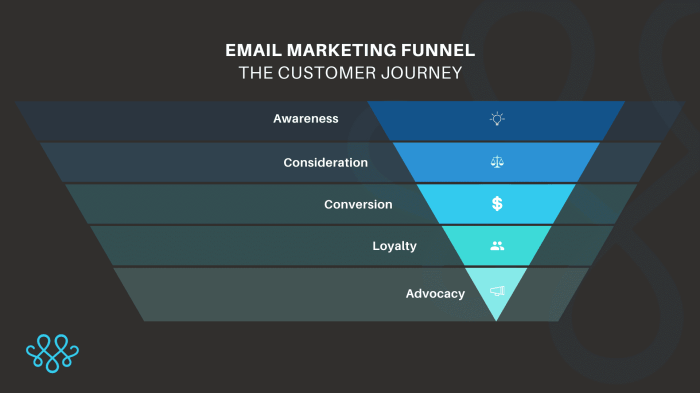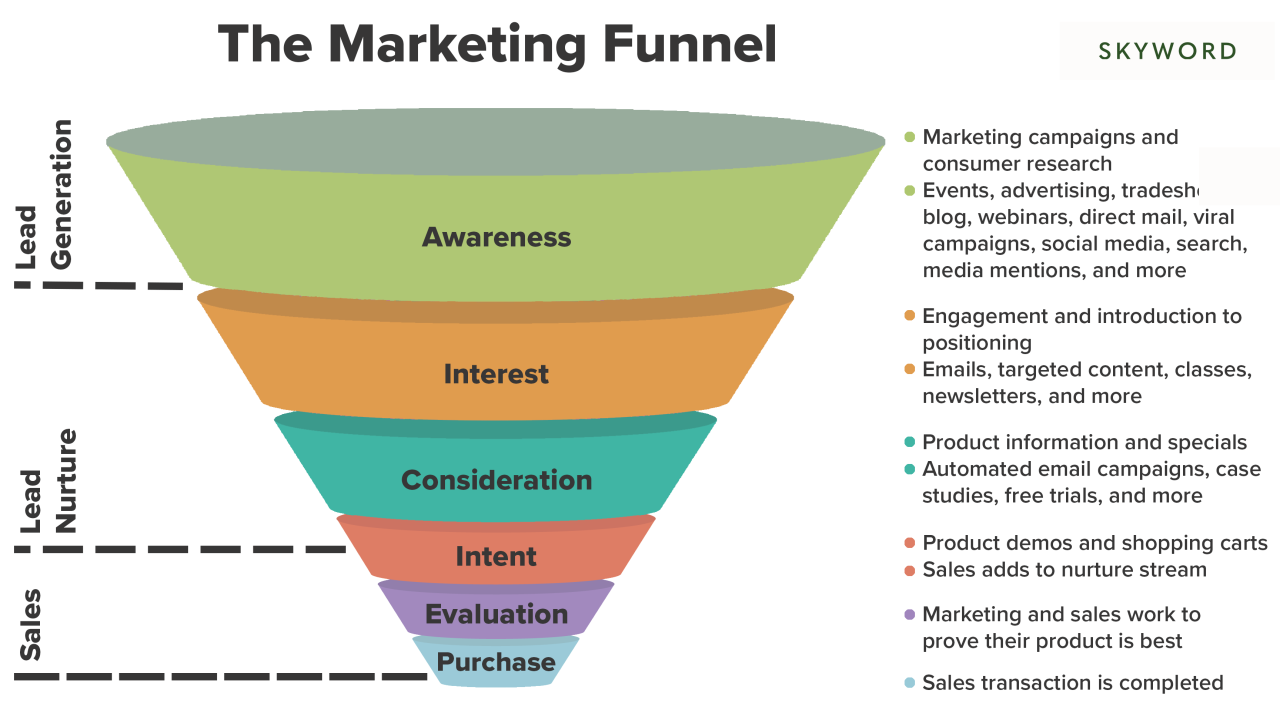Building an Email Marketing Funnel sets the stage for boosting your business with targeted strategies that drive results. Dive into the world of email funnels where conversion meets creativity.
Learn the ropes of crafting compelling sequences, automating processes, and measuring success like a pro. Let’s take your email game to the next level!
Importance of Email Marketing Funnels
Email marketing funnels play a crucial role in the success of businesses by guiding potential customers through the buying process. These funnels help in building relationships with leads and nurturing them towards conversion. Let’s dive deeper into why email marketing funnels are essential for businesses.
Lead Nurturing and Conversion
- Email marketing funnels allow businesses to segment their audience based on their interests and behaviors, delivering targeted content that resonates with each group. This personalized approach increases engagement and builds trust with leads over time.
- By sending a series of emails at different stages of the customer journey, businesses can educate leads about their products or services, address their pain points, and showcase the value they offer. This gradual nurturing process moves leads closer to making a purchase decision.
- Successful email marketing funnel strategies often include a mix of educational content, promotional offers, customer testimonials, and personalized recommendations. By providing valuable information and addressing the needs of leads, businesses can increase their chances of converting them into customers.
Components of an Email Marketing Funnel

Creating a successful email marketing funnel involves several key components working together to attract, engage, and convert subscribers into loyal customers.
Lead Magnets
Lead magnets play a crucial role in attracting subscribers to your email list. These are valuable incentives offered to website visitors in exchange for their email addresses. Lead magnets can include free guides, ebooks, templates, or exclusive discounts that provide immediate value to the subscriber.
- Lead magnets should address a specific pain point or need of your target audience to attract the right subscribers.
- They help build trust and establish credibility with your audience, increasing the likelihood of them engaging with your emails.
- Effective lead magnets can significantly increase your email list’s growth and lead to higher conversion rates.
Segmentation
Segmentation involves dividing your email list into smaller, more targeted groups based on specific criteria such as demographics, behavior, or engagement level. This allows you to send more personalized and relevant content to each segment, improving engagement and conversion rates.
- Segmentation helps you tailor your messages to the unique preferences and interests of different subscriber groups.
- By sending targeted emails, you can deliver more relevant content that resonates with each segment, leading to higher open and click-through rates.
- Segmentation also enables you to create automated email campaigns that deliver the right message at the right time, increasing the chances of conversion.
Designing an Effective Email Sequence
When it comes to creating engaging and personalized email sequences, there are a few key tips to keep in mind. First, make sure to segment your email list based on different criteria such as interests, behaviors, or demographics. This will allow you to send more targeted and relevant content to your subscribers. Additionally, use dynamic content to personalize each email based on the recipient’s preferences or past interactions with your brand.
Yo, have you heard about using case studies for lead generation? It’s like, super important for businesses to showcase their success stories and build credibility. Check out this dope article on Using Case Studies for Lead Generation to learn more about how it can help your hustle!
This can help increase engagement and conversion rates.
Hey, have you heard about the latest trend in marketing? Using Case Studies for Lead Generation is all the rage right now! Companies are sharing real-life success stories to attract new customers and boost sales. Check out this article on Using Case Studies for Lead Generation to learn more about this effective strategy.
Ideal Frequency for Sending Emails in a Funnel
- It is important to find the right balance when it comes to the frequency of sending emails in a funnel. Sending too many emails can overwhelm subscribers and lead to high unsubscribe rates, while sending too few emails can cause subscribers to forget about your brand.
- A good rule of thumb is to send emails consistently but not excessively. This could mean sending weekly newsletters or bi-weekly updates, depending on your audience and the type of content you are sharing.
- Monitor your email metrics such as open rates, click-through rates, and unsubscribe rates to determine the optimal frequency for your email funnel.
Significance of A/B Testing in Optimizing Email Sequences
- A/B testing, also known as split testing, is crucial for optimizing email sequences. It involves creating two versions of an email with slight variations in elements such as subject lines, call-to-action buttons, or images, and sending them to a small portion of your email list to see which version performs better.
- By analyzing the results of A/B tests, you can gain valuable insights into what resonates with your audience and make data-driven decisions to improve the effectiveness of your email sequences.
- Continuously testing and refining your email content based on A/B testing results can lead to higher open rates, click-through rates, and ultimately, better conversion rates.
Automation and Integration
In the world of email marketing funnels, automation and integration play a crucial role in streamlining processes, saving time, and increasing efficiency.
Benefits of Automating Email Marketing Funnels
Automating email marketing funnels brings a plethora of benefits to the table, including:
- Increased efficiency by sending targeted and personalized emails at the right time.
- Improved engagement with subscribers through timely follow-ups and relevant content.
- Cost-effectiveness by reducing manual labor and allowing for scalable campaigns.
- Enhanced tracking and analytics to measure the performance of email sequences.
Importance of Integrating Email Marketing Funnels with CRM Systems
Integrating email marketing funnels with Customer Relationship Management (CRM) systems is essential for:
- Seamless data synchronization between email lists and customer profiles.
- Enhanced targeting and segmentation based on customer behaviors and interactions.
- Automated lead nurturing and sales pipeline management for a more streamlined process.
- Improved customer insights and a 360-degree view of the customer journey.
Tools for Automation and Integration, Building an Email Marketing Funnel
There are various tools available in the market that facilitate automation and integration processes, such as:
- Email Marketing Platforms: Platforms like Mailchimp, ActiveCampaign, and HubSpot offer automation features to create and manage email sequences.
- CRM Systems: Tools like Salesforce, Zoho CRM, and HubSpot CRM help integrate email marketing funnels with customer data for a unified approach.
- Marketing Automation Software: Platforms like Marketo, Pardot, and Eloqua provide advanced automation capabilities to streamline marketing processes.
- Integration Tools: Services like Zapier and Integromat allow for seamless integration between different apps and systems for a cohesive workflow.
Measuring Success and Optimization: Building An Email Marketing Funnel

In order to ensure the effectiveness of your email marketing funnel, it is crucial to measure success and continuously optimize based on the data collected. By tracking key metrics, implementing strategies for improvement, and utilizing feedback loops, you can refine your email sequences for better results.
Key Metrics for Tracking Performance
- Open Rate: This metric shows the percentage of recipients who open your emails. A high open rate indicates strong subject lines and engaging content.
- Click-Through Rate (CTR): The CTR measures the percentage of recipients who click on links within your emails. It indicates the effectiveness of your call-to-action and content.
- Conversion Rate: This metric tracks the percentage of recipients who complete a desired action, such as making a purchase or signing up for a webinar, after clicking on a link in your email.
- Bounce Rate: The bounce rate shows the percentage of emails that were not delivered successfully to recipients’ inboxes. A high bounce rate may indicate issues with your email list quality.
Optimizing Email Marketing Funnels
- Analyze Data: Regularly review key metrics to identify trends and patterns in your email marketing performance. Use this data to make informed decisions about optimizing your email sequences.
- A/B Testing: Experiment with different subject lines, content formats, and calls-to-action to see what resonates best with your audience. Optimize based on the results of these tests.
- Schedule Automation: Set up automated workflows based on user behavior to deliver personalized content and drive engagement. Continuously optimize these workflows for better results.
Role of Feedback Loops
Feedback loops play a crucial role in refining and improving email sequences by providing insights from recipients’ responses. By analyzing feedback from opens, clicks, and conversions, you can tailor your content to better meet the needs and preferences of your audience. Incorporating feedback into your optimization strategy can lead to higher engagement and conversion rates.
